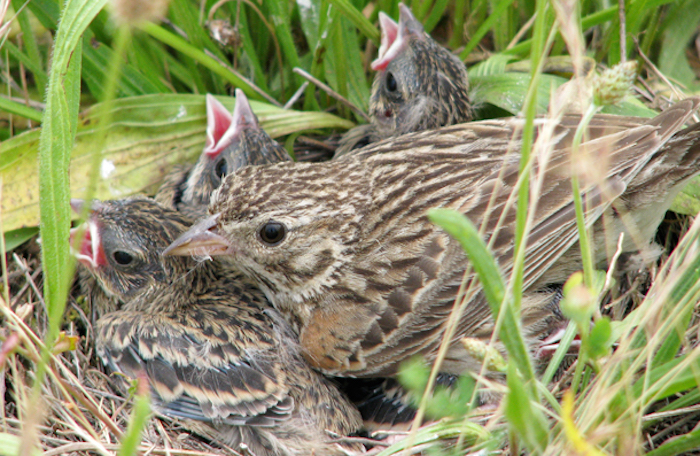
Vesper Sparrow with Nestlings by Suzanne Beauchesne
Calls for Oregon Vesper Sparrow to be Listed under the Endangered Species Act
(Washington, D.C., Dec. 21, 2016) American Bird Conservancy has petitioned the U.S. Fish & Wildlife Service to list the Oregon Vesper Sparrow as a threatened or endangered species under the Endangered Species Act (ESA). In a letter sent to Sally Jewell, Secretary of the Interior, ABC describes this subspecies of the Vesper Sparrow as highly imperiled and threatened with extinction throughout its range.
The petition makes the case that the species warrants listing because of significant population declines and ongoing habitat loss and degradation, among other threats, and because it lacks adequate protection under existing regulatory mechanisms.
Without ESA listing, the sparrows’ future looks grim. The current estimated population of the Oregon Vesper Sparrow is fewer than 3,000 birds, and Breeding Bird Survey data indicates a statistically significant population decline of more than five percent every year over the last 45 years.
This migratory species has a restricted breeding range that historically included southwestern British Columbia, western Washington and Oregon, and northwestern California. Now, breeding populations have disappeared from British Columbia and California, along with numerous local breeding populations throughout the range.
The species overwinters in California west of the Sierra Nevada Mountains and south of San Francisco Bay, and historically it ranged into northwestern Baja California, Mexico. But wintering populations in Baja and southern parts of California have now disappeared.
“We are deeply concerned about the future of this bird,” said Bob Altman, ABC’s Pacific Northwest Conservation Officer. “With so few birds remaining, many in small and isolated populations, the Oregon Vesper Sparrow needs the immediate protection and conservation focus made possible through ESA listing.”
Several primary threats are driving the sparrow’s decline:
- The continuing loss and degradation of its grassland and savannah habitats because of development, conversion of those habitats to intensive agriculture, and the encroachment of invasive shrubs, trees, and exotic grasses;
- Harmful or poorly timed land-use activities such as mowing, overgrazing, military training, and recreational use; and
- The vulnerability of small, isolated breeding groups of birds.
“Every year, more populations are being lost, and we are not seeing the establishment of new populations where habitat restoration has occurred,” Altman said.
Existing regulatory mechanisms do not provide the protection needed to prevent the Oregon Vesper Sparrow from continuing on its trajectory toward extinction. There are no Federal or State programs dedicated to its conservation, and only about 20 percent of the birds’ range-wide population occurs on public lands. Without ESA listing, this vulnerable species will continue to decline and is likely to disappear forever.
###
American Bird Conservancy is the Western Hemisphere’s bird conservation specialist—the only organization with a single and steadfast commitment to achieving conservation results for native birds and their habitats throughout the Americas. With a focus on efficiency and working in partnership, we take on the toughest problems facing birds today, innovating and building on sound science to halt extinctions, protect habitats, eliminate threats, and build capacity for bird conservation.
Contact: Bob Altman, ABC’s Pacific Northwest Conservation Officer, 541-760-9520

Comments are closed.